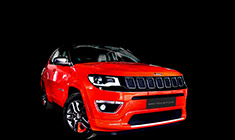News
DIY: Installing new rear shocks on my 15-year-old Maruti Swift
The ride has improved & the rear doesn't bounce a lot as earlier.
BHPian Ashtoncastelino recently shared this with other enthusiasts.
My Swift rear shockers were due for replacement as the right rear shocker was leaking.

Taking advantage of the recent Boodmo sale, I immediately ordered rear shockers while keeping Shashi in the loop.
The new shocks were of Gabriel's make. January 2022 manufactured.
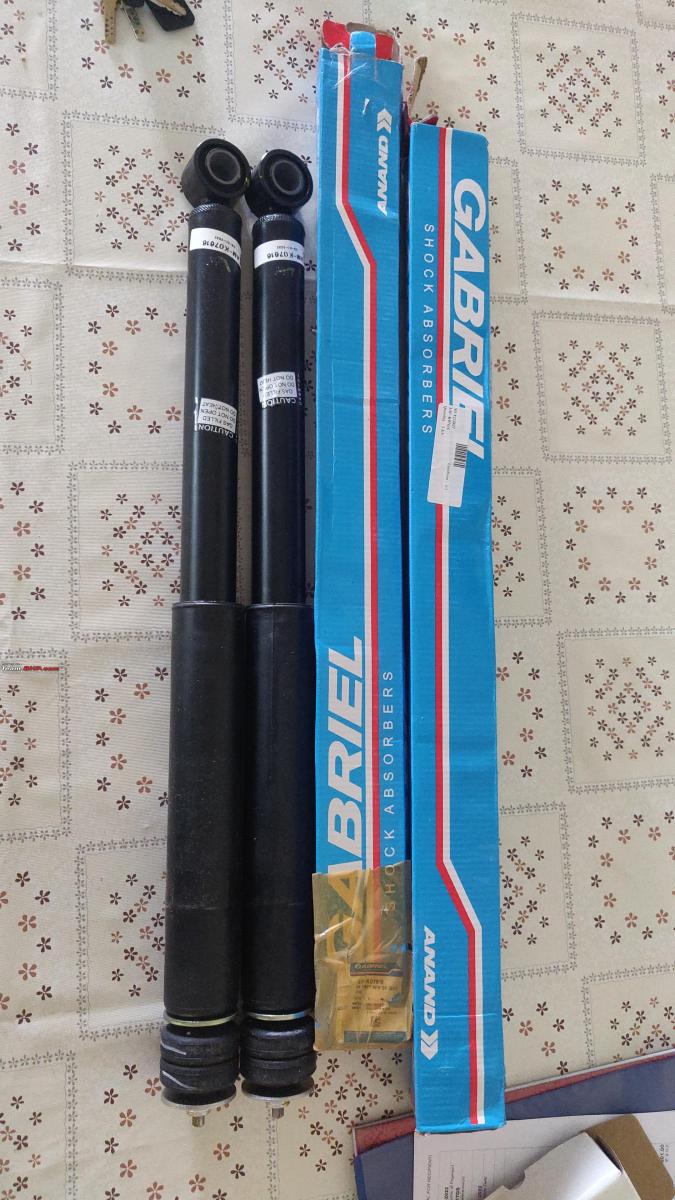
I planned to do the replacement as DIY at home with the help of my dad as we have all the required tools or so we thought ( more on that later).
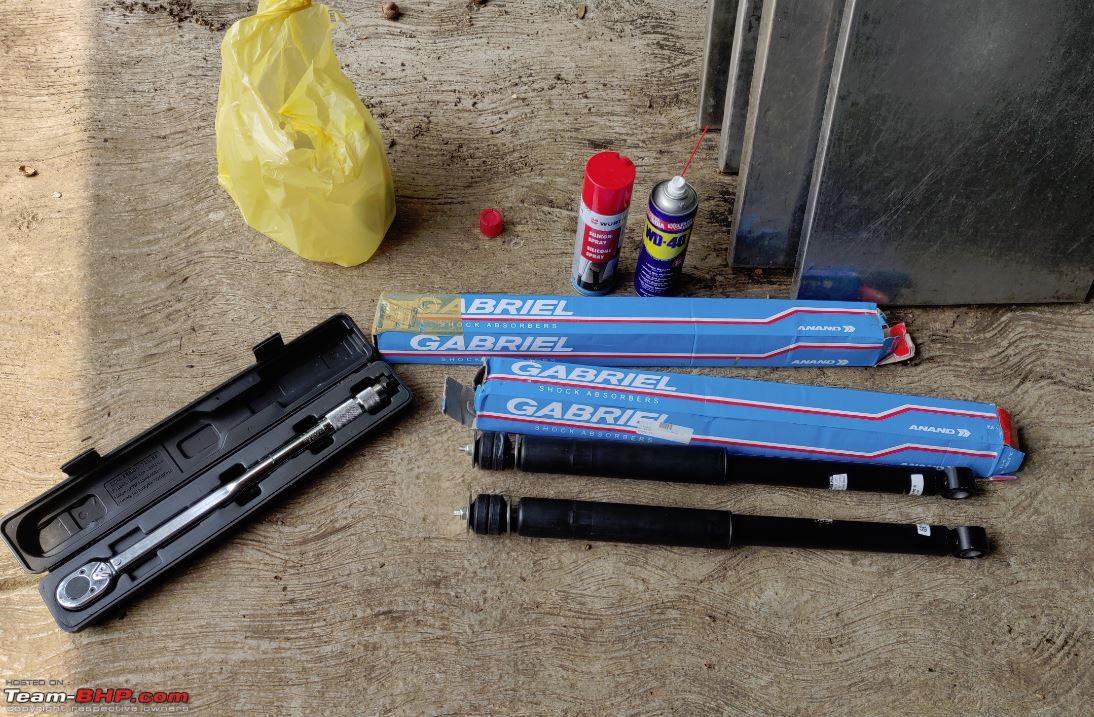
So yesterday we lifted the car at home, unscrewed the bottom nut of the shocker and proceeded to remove the upper one and boom, here comes the surprise.
Left shocker Upper Bolt
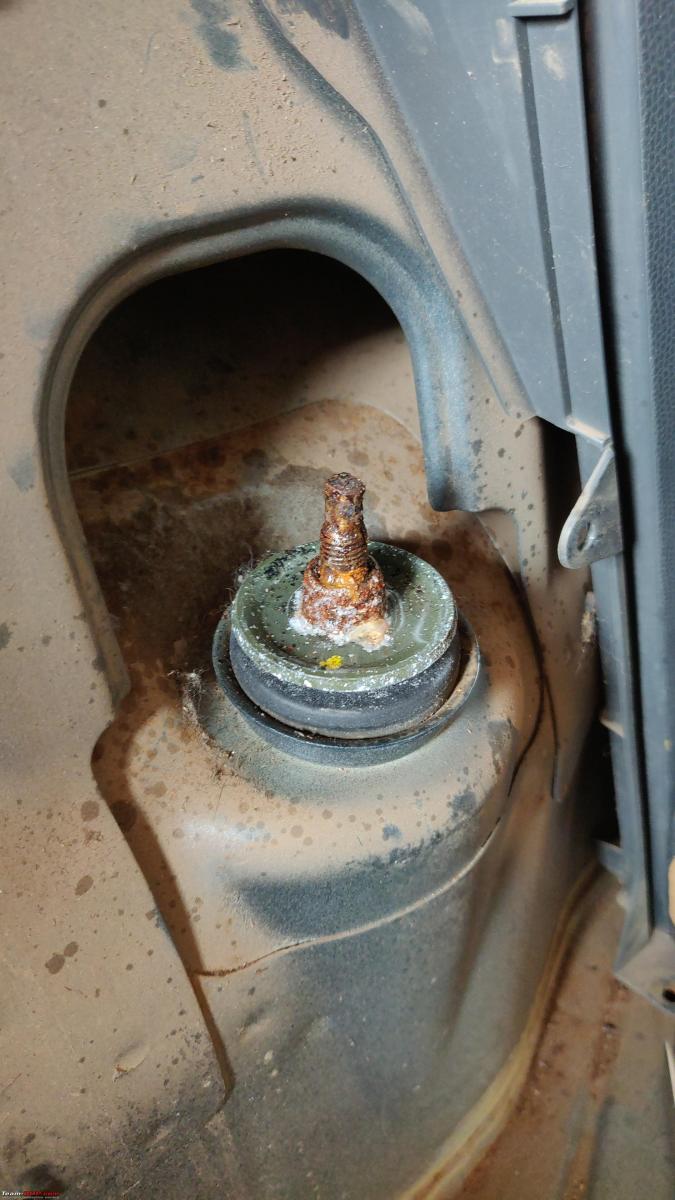
Right shocker Upper bolt
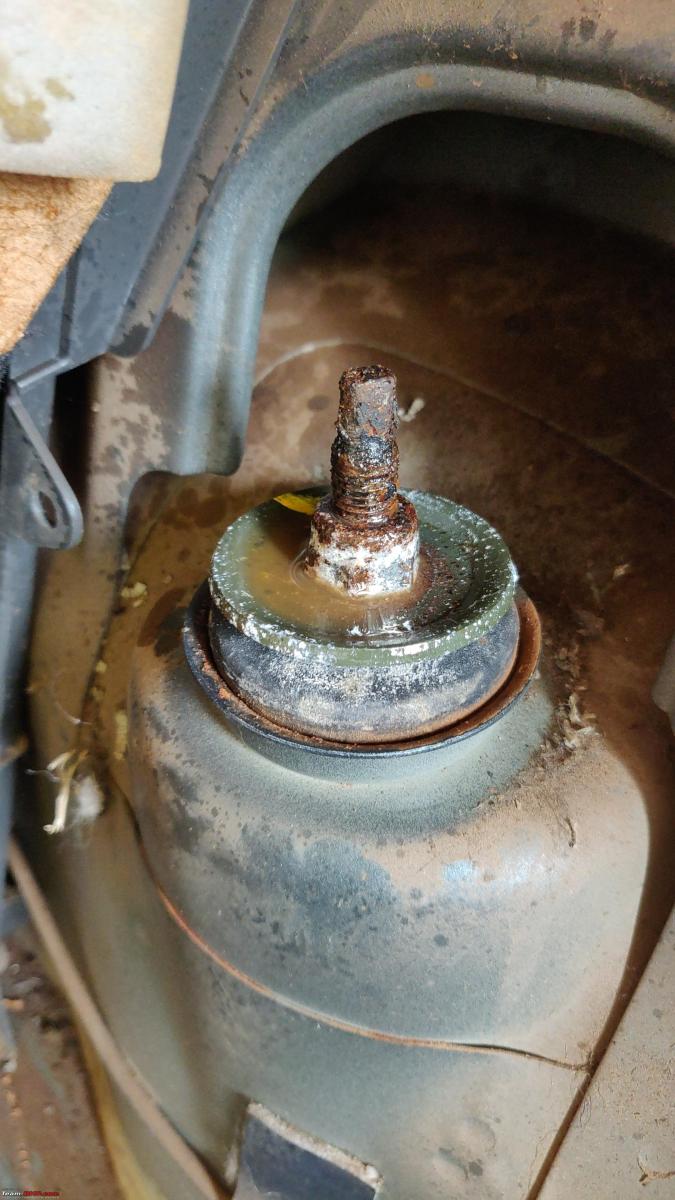
These are definitely the stock rear shockers which came with the car 15 years ago (2006). The nuts are basically seized, we hammered and did whatever we could but the nut would not even budge. Sprayed WD40 and left it to soak but still no luck. Yes it was that bad. At this point , we thought the only thing left is to remove it with heat. I did not want to follow this method as it would lead to further rusting around the surrounding area in the future.
Dad being the expert he is, told me to find a angle grinder to cut the bolt off. We did not have an angle grinder and It being a sunday, no workshops were open. Luckily for us, our neighbour is a carpenter , he had an angle grinder with him and we were so relieved when he gave us a confirmation.
So I started covering all the surrounding areas with wet rags and dad started to cut off the nut.
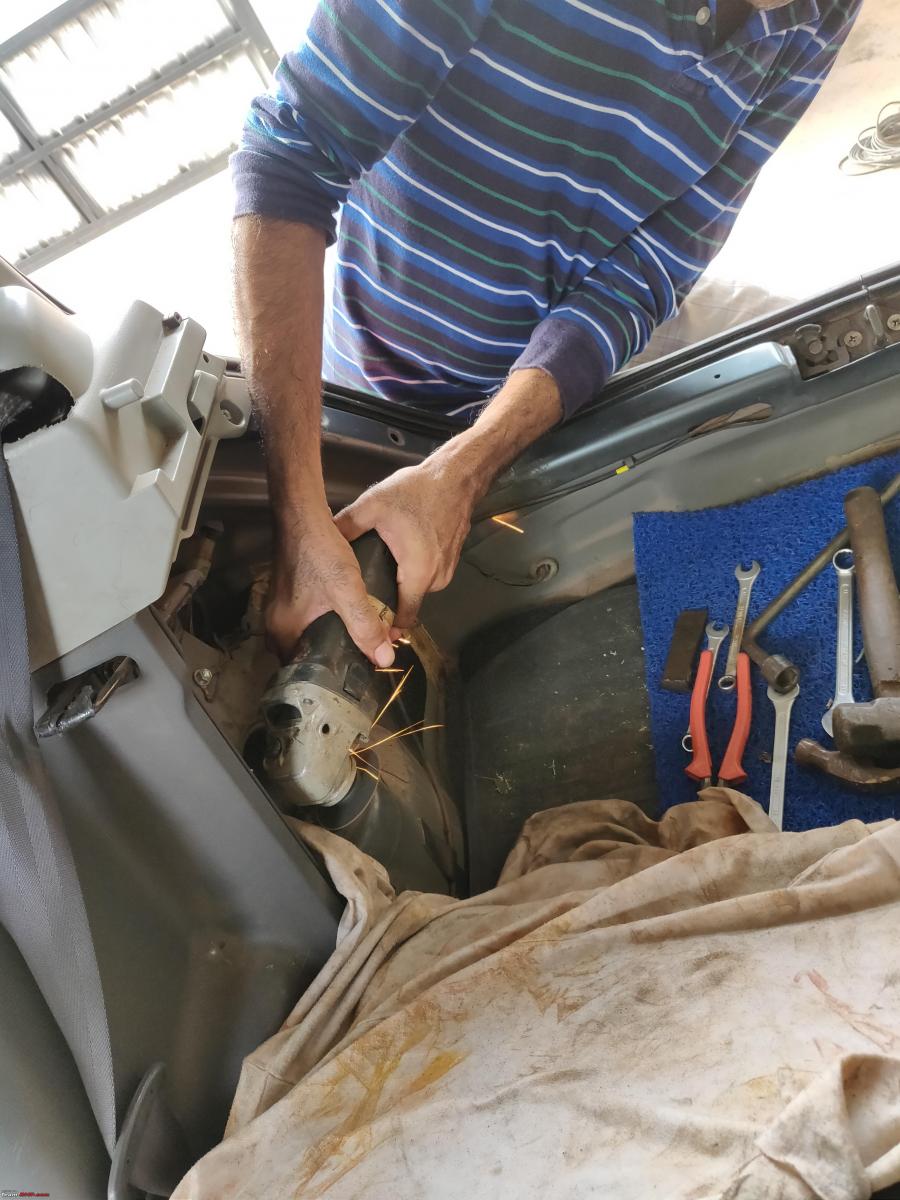
Comparison of old and new Shocker.
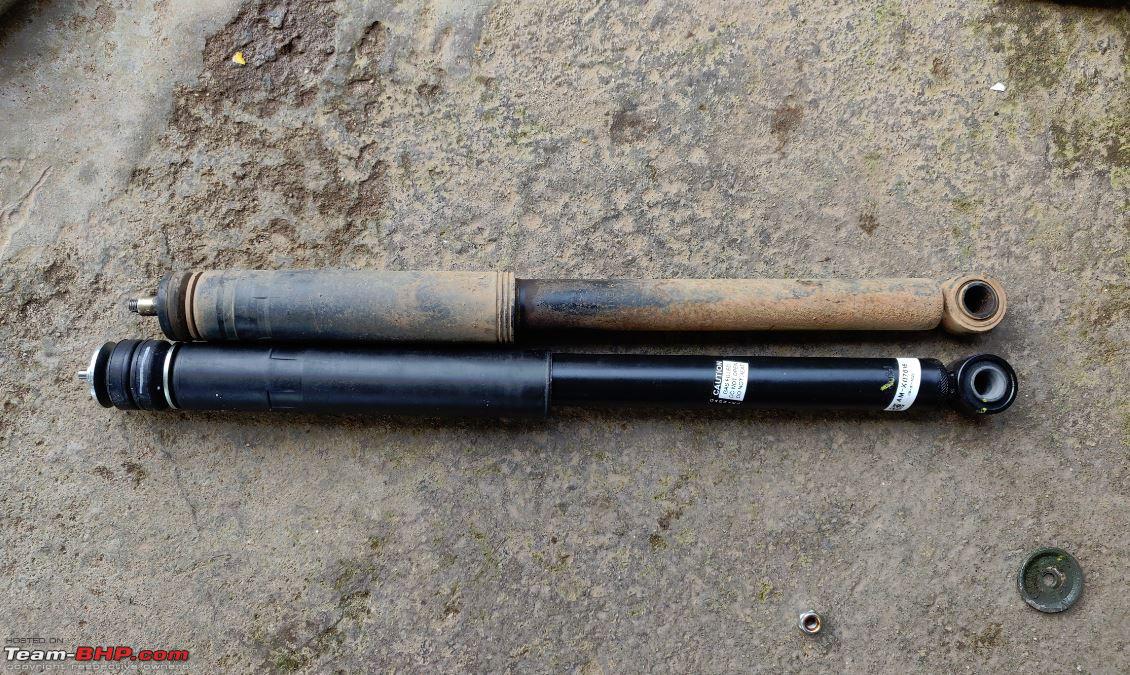
Both rear shockers removed. They were of Delphi make.
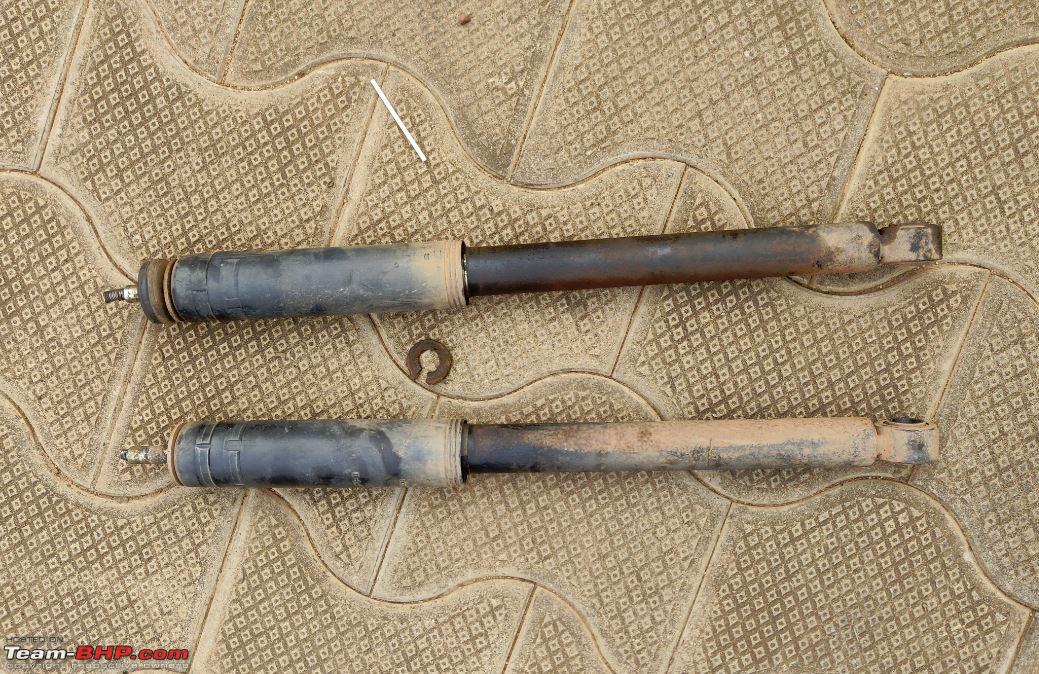
Thankfully all went well and the ride is so much better. Applied a bucket of grease on the mountings and nuts. Now after the replacement the rear doesn't bounce a lot like earlier.
Lesson Learnt!
Always apply grease on all strut mountings and bolts as Shashi has done. He has mentioned it on page 1, else its pretty obvious you'll end up in the same situation I was in.
Check out BHPian comments for more insights and information.
News
How I achieved 23.6 km/l on my 2015 Maruti Swift petrol
Prior to this, the best fuel efficiency figure I had managed to get was 19 km/l.
BHPian Crow recently shared this with other enthusiasts.
This is the story of how I extracted an insane fuel efficiency of 23.6km/l over a distance of 830 km on my 2015 Maruti Swift ZXI (petrol). It also includes some fun things I did in Vadodara, so if you came here for fuel efficiency tips, you should definitely stay for the "things to do" section.
Stopped the car just to take a picture of the MID.
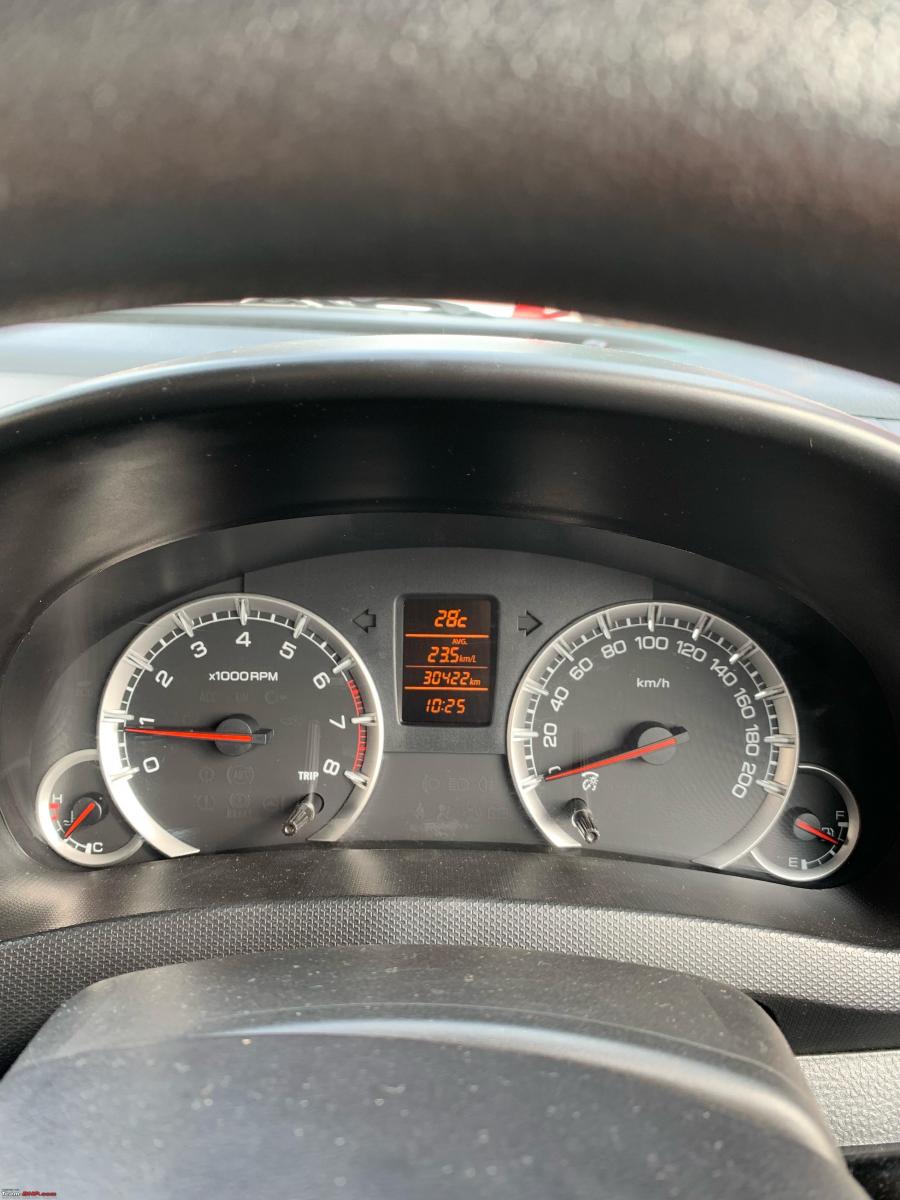
Quick index:
- How I achieved 23+kmpl
- A tryst with Modernist Coffee
- Meeting D-BHPian @vishy76
- Good eateries and trusted places on the Mumbai-Vadodara-Mumbai route of NH-48
The pandemic has made me realize that it's better to hit my bucket list items sooner rather than later, and a solo long drive has always been something I intended to do. There were many ideas such as driving to Gir Forest, South India, MP, etc, but I had a commitment to honour. One of my closest friends lives in Vadodara and we'd been planning to go check out multiple cafes in Surat for a while. Apparently, the coffee culture in Surat is really picking up, and he wanted to show me around.
I'm not really a coffee person myself, but I figured why not try this new thing out? So it was decided that I'd be heading towards Vadodara for sure and maybe a stop for the cafes at Surat on the way back. Sadly I saw a thick blanket of smog around Surat bypass while going to Vadodara and we both decided to cancel that leg of the trip immediately. Maybe it'll happen in the summer!
The problem with starting very early is that popular hangouts, like McDonald's Surat and Hotel Ahura in Talasari, aren't open!
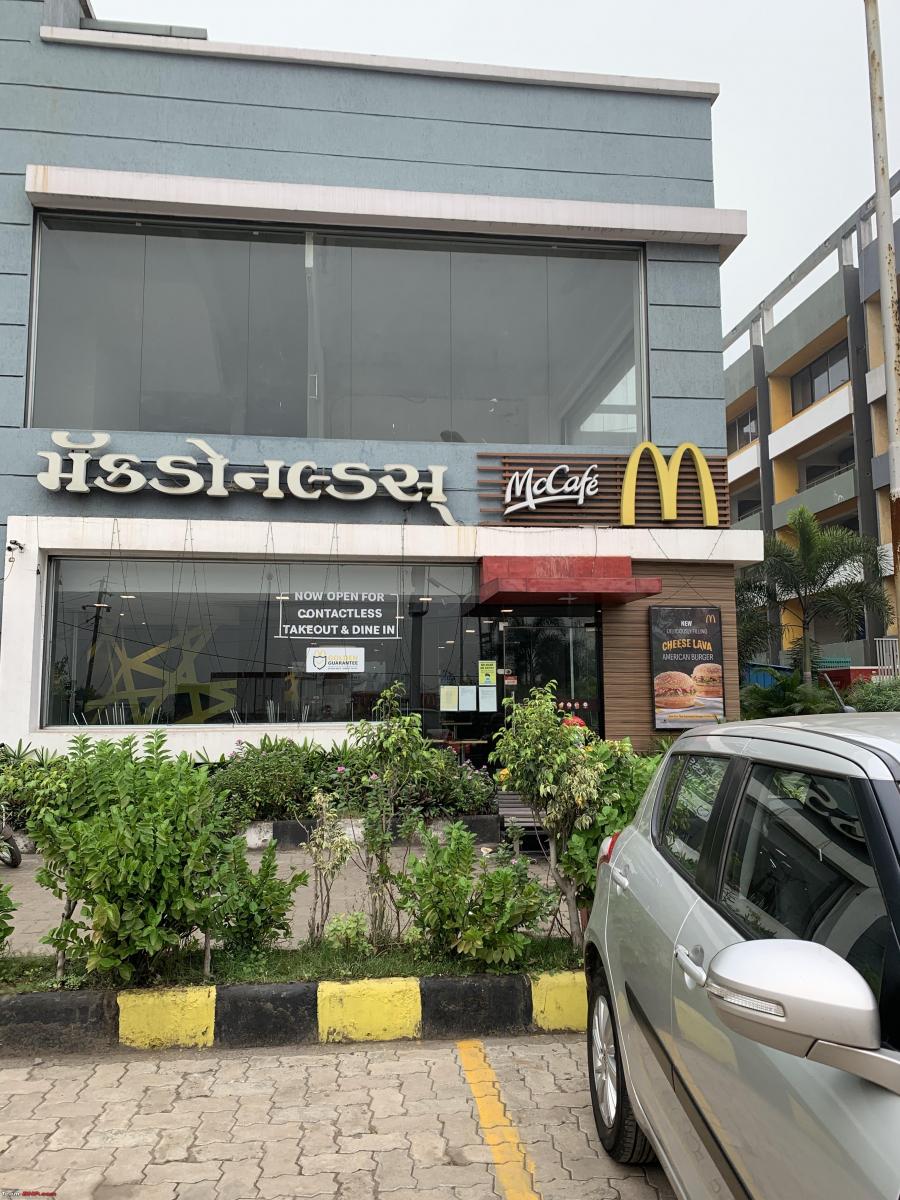
That's when I got the next brainwave and asked my friend if he'll come to Delhi with me to check out some things I've been missing a lot from the national capital. My friend, being the sport that he is, agreed immediately. My next question: "Why don't we drive to Delhi?" was met with a long silence and eventual denial. He wasn't up for that long a drive, so we finalized the plan — I drive solo from Mumbai to Vadodara, park the car at his house, and we drive to Delhi.
The Delhi trip was amazing in its own way, but details of that are for another thread. In this thread, I'm going to focus on my drive to Vadodara and back, and the fun things I did there. I visited the best cafe I've ever visited in my life. I met an amazing D-BHPian. And I drove an absolute beast of a car there (more on this in a different thread).
I had full faith in my ability to reach Vadodara without issues in my Maruti Swift ZXI (2015). The car has done almost 31,000km in six years, and 16,000 of those have been done in the last two years (including six months of running zero km due to the lockdown). I've driven almost exclusively on the highways in this time. However, I've never driven solo for that long, so I wasn't sure if I'd be able to stay awake for eight hours during this drive. That's when I got an idea—why not try a hypermiling run to Vadodara?
I've been massively inspired by D-BHPian @PrasannaDhana's threads and I asked him how he got 26 km/l from a Kwid. He pointed me to one of his posts, which had some useful tips. I've quoted it below for quick reference.
These are the simple measures I implement while driving the Storme:
- Gradual acceleration and deceleration. Very very rarely does the rev needle go up fast (I used to floor my Ciaz all the time and still get 18 km/l )
- Being in the highest gear possible without lugging the engine. Luckily Storme Varicor 400 has great drivability. You can stay at 1000 rpm and still see good progress with a dab on the accelerator
- Anticipating braking. When there is slow-moving traffic or an obstacle, say 200 meters away, I take my foot off the gas pedal and coast it till that spot.
- Coasting when possible. Especially on downward slopes. The 2+ tonne kerb weight of the Storme aids in maintaining the momentum downhill. You will be surprised to know that I have done over 1.5 km without any accelerator input coming from a large over the bridge.
- Maintaining optimal highway speeds. Specifically 80-100 km/h, mostly 90 km/h
- Proper tyre pressure. 32 psi recommended for low load driving. I maintain 33 psi
- AC set to eco mode. Storme has an extremely powerful ac (like all Tatas). I use the ac in Eco mode which itself is sufficient. If I have rear passengers, I use the rear ac or else it's just the front AC in eco mode at blower level 1.
- No idling unnecessarily. No short trips (<5km) unnecessarily.
With this knowledge at hand, I knew that it was possible to extract more mileage from my Swift. I've never really bothered with tankful measurements — the MID's accuracy is good enough for me. The maximum fuel efficiency I've ever got on my petrol Swift is 19.8km/l, on the way back from Rajasthan to Mumbai in 2019. On all recent drives, the best I've managed is 18.8km/l on the way back from Goa.
So off I went into this trip trying to see what I could do in terms of fuel efficiency. I started the journey at 0420 hours (really!) on November 23, 2021, and navigated past the usual road closures and other detours on the Western Express Highway in Mumbai.
In no time I was already past the dreaded Vasai Creek bridge near Hotel Fountain and that's when my Swift's mediocre headlights made it hard to go faster than 60-70km/h. There are no lane markings in this part of the road, for a few km, so I was going really slowly. By the time I reached the stretch with lane markings, my MID was already at almost 19km/l!
I assumed it was the lower temperatures coupled with lower weight in the car that got it up so fast and though it really can't get better than this.
So, I used the following methods to see if my car can get better fuel efficiency:
- Completely let go of my ego. Never react to any drivers with poor road manners and move aside for anyone who wants to overtake, even if that person is in a vastly inferior vehicle.
- Befriend anticipatory braking, absolutely no sudden brakes as much as possible.
- Maintain steady speeds between 75 and 90km/h.
- Try to follow sedately driven cars at a safe distance to reduce wind resistance.
- Accelerate and decelerate gradually, always!
- Use the recommended tyre pressure for your vehicle and tyre size. It's 29psi on my Swift ZXI, but I filled it to 30psi for the trip.
Other conditions were in my favour too:
- An early start combined with winter meant lower temperatures throughout the drive, which is better for fuel-efficiency.
- Driving on excellent tar roads on the NH48 ensures better grip, less road noise, and makes it easier to control the car for me.
- With just one person in the car, the weight was as low as it could be. Even my luggage was under 15kg total.
All these things combined to make the average fuel efficiency number on the MID rise gradually. Over a distance of 410km from my home to my friend's home, the number rose to a staggering 23.6km/l!!! I never thought that it was possible to extract almost 24km/l from a petrol car on a long highway run, but that's what happened. I reached Vadodara with less than half a tank of fuel consumed, which is frankly quite insane!
The 2015 Swift ZXI has a 42-litre fuel tank if I remember correctly, so by my calculations, I used around 34 litres to reach Vadodara and get back home. A total trip distance of around 830km was done with some fuel to spare! (Of course, I refilled the car before leaving Vadodara, I do not like taking chances with things like that.) If I'd had a longer trip planned, I could have driven another 180-odd km with some petrol still left in the tank. The total range of one fuel tank rises to over 1,000km with this kind of sedate driving. I've never heard of petrol car drivers reporting these numbers in my limited experience. The stories I've heard are all from diesel car owners who report crazy numbers north of 22km/l fairly regularly.
Here are some useful stats for the trip.
Mumbai to Vadodara:
- Distance: 430km
- Average fuel efficiency (at the end of the trip): 23.3km/l
- Top speed: Roughly 95km/h
- Start time: 0420 hours
- Arrival time: 1120 hours
- Total time (including breaks): 7 hours
- Average speed: 61.7km/h
The MID before leaving Mumbai.

The MID at the end of the first leg of the trip.

Vadodara to Mumbai:
- Distance: 430km
- Average fuel efficiency (at the end of the trip): 23.2km/l
- Top speed: Roughly 100km/h
- Start time: 0440 hours
- Arrival time: 1205 hours
- Total time (including breaks): 7.5 hours
- Average speed: 57.3km/h
The MID before leaving Vadodara.
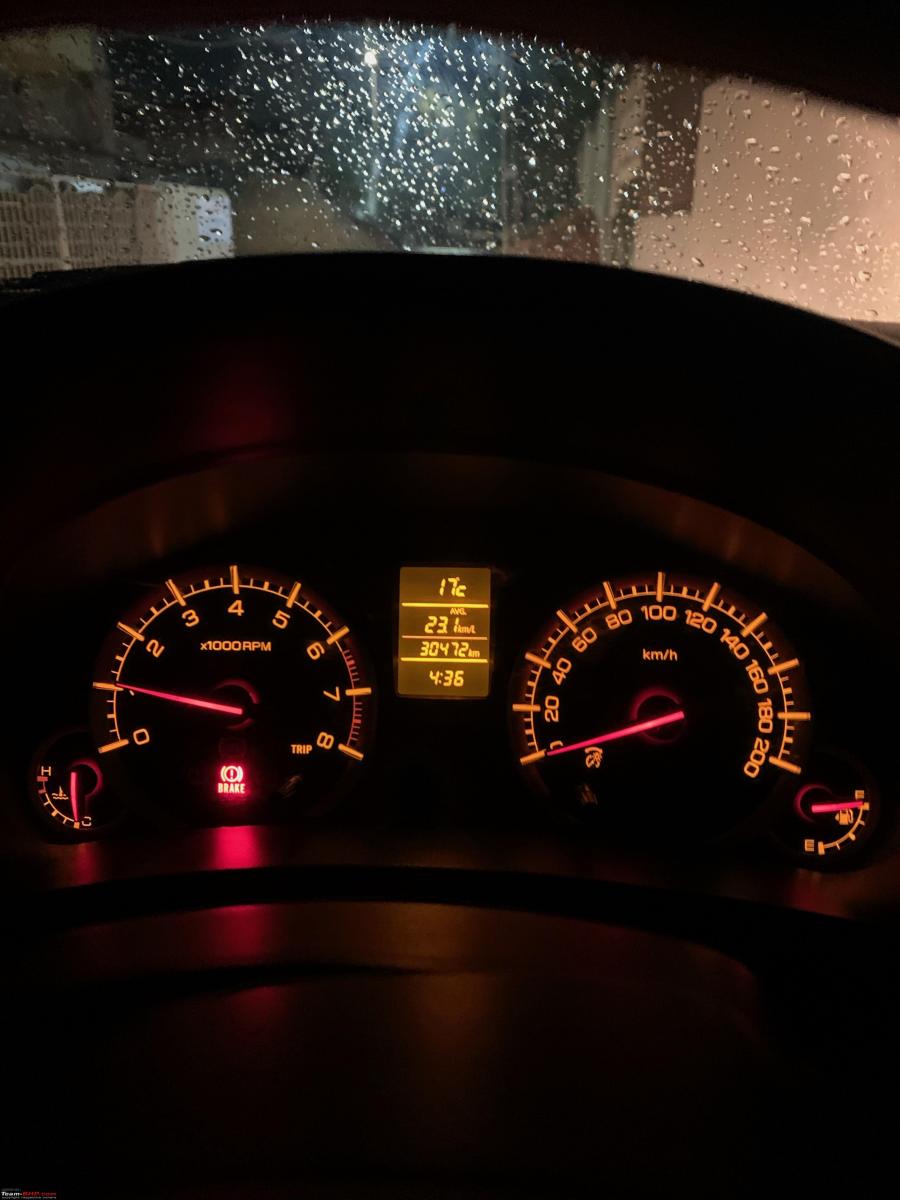
The MID after reaching Mumbai.
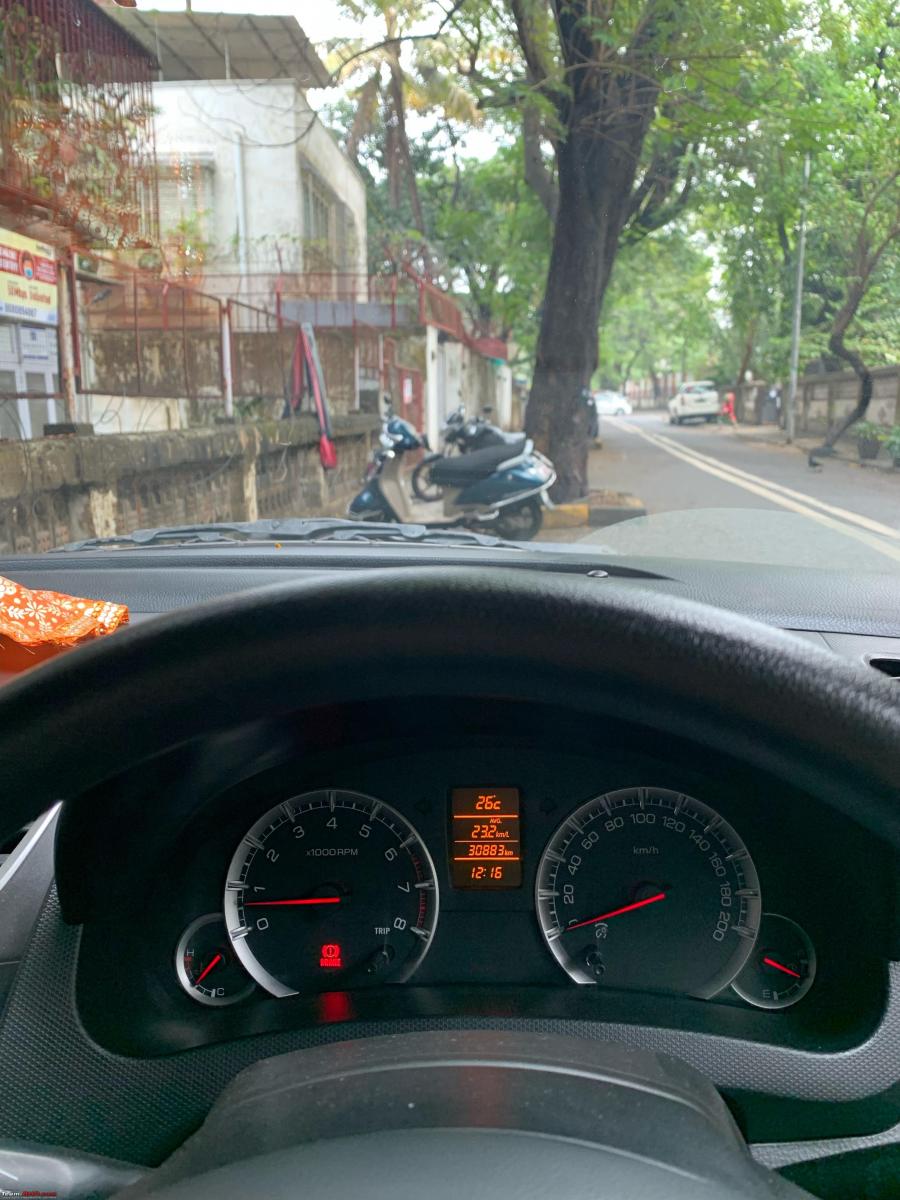
Mumbai traffic and some difficult driving conditions didn't allow me to be as disciplined as I was on the return leg. It was pouring for about 60% of the journey and spray from other vehicles, combined with poor road manners from heavy vehicles made it hard to avoid braking. Yet I managed a maximum of 23.4km/l on this leg.
I am very, very proud of this achievement. I never really thought of myself as a great driver with amazing skills. I always feel that Team-BHP has people who are so, so much more knowledgeable and experienced than I am. Just to be able to do something noteworthy gives me an immense sense of satisfaction. If I can do this, pretty much anyone can. Now just give me a light diesel car and watch as I hit 30km/l on it for sure!
Continue reading BHPian Crow's hypermiling journey for more insights, comments and information.
- Tags:
- Indian
- Swift
- fuel efficiency
News
DIY: Restoring my Maruti Swift's headlights for just Rs 400
A new set of OEM headlights from Maruti Suzuki would have set me back by over Rs 5000.
BHPian Ashtoncastelino recently shared this with other enthusiasts.
For those who have oxidized and hazy headlights which reduce your light output and make your night drives difficult, hope this DIY guide helps you freshen up your headlights. An OEM new Swift headlight will cost you about ₹2525 per side, So in total ₹5050 for a pair.
I for long had the itch to restore my headlights ever since I got the car in June last year because they started yellowing, had scratches, were oxidized, had hard water spots and while the previous owner had the car re-painted, the painter didn’t cover the headlights leading to overspray of clear coat over them.
Friend and fellow BHPian yuv3447 guided me while doing this DIY. Huge thanks to you brother!
Condition of the headlights before restoring




Things you need:
- 800 grit sandpaper
- 1500 grit sandpaper
- 3M Marine Paste (Rubbing compound)
- 3M Premium Liquid Wax
- Orbital Polishing Machine
- Elbow grease (trust me)
- Lots of Patience
Price for this sweet DIY?
- 800 grit sandpaper - ₹25
- 1500 grit sandpaper - ₹35
- 3M Marine Paste (Rubbing compound) - ₹193
- 3M Premium Liquid Wax -₹156
- Orbital Polishing Machine (I had borrowed the orbital polishing machine from a good friend.)
Total: ₹409
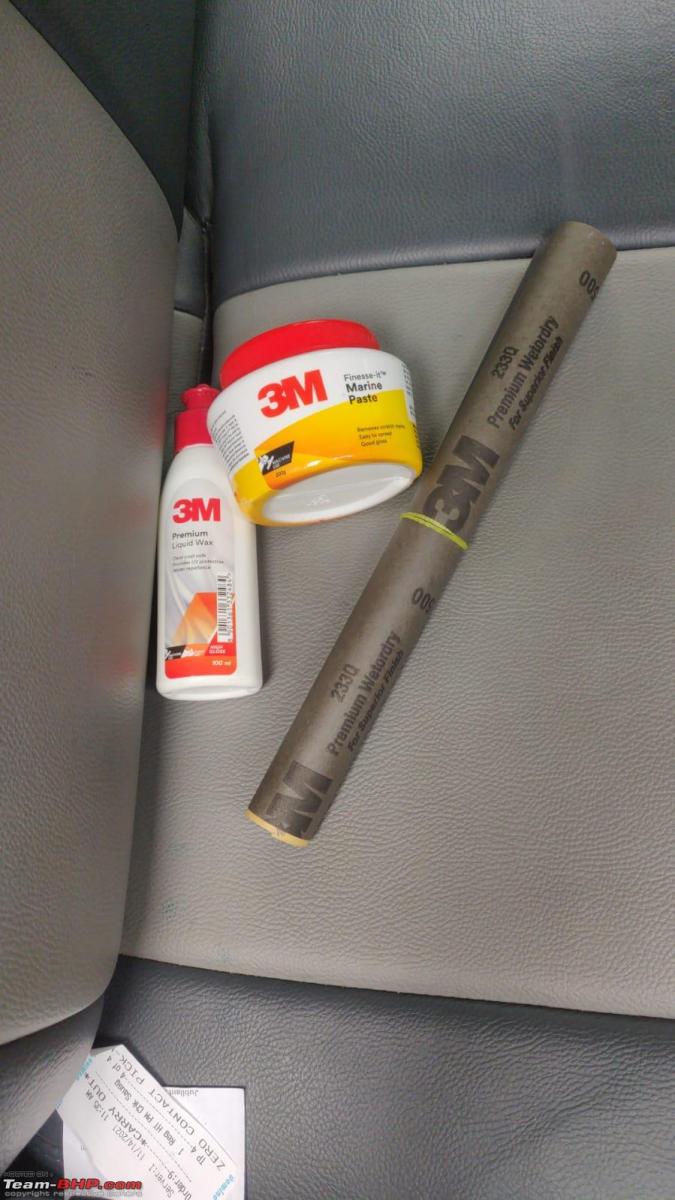
Procedure:
1) Remove the bumper: To make things easier, I removed the front bumper. Removing the bumper is a fairly easy process. I asked my younger cousin to assist me in removing the bumper.
I have marked the positions of all the screws, clips and bolts which hold the bumper to the body. The screws are marked in green arrows, clips by orange arrows and bolts by yellow arrows.

Once you remove all of them, lift the bumper from the top carefully and it will come off.
Unfortunately, while I was performing this DIY, it unexpectedly started raining all of a sudden. Bummer!
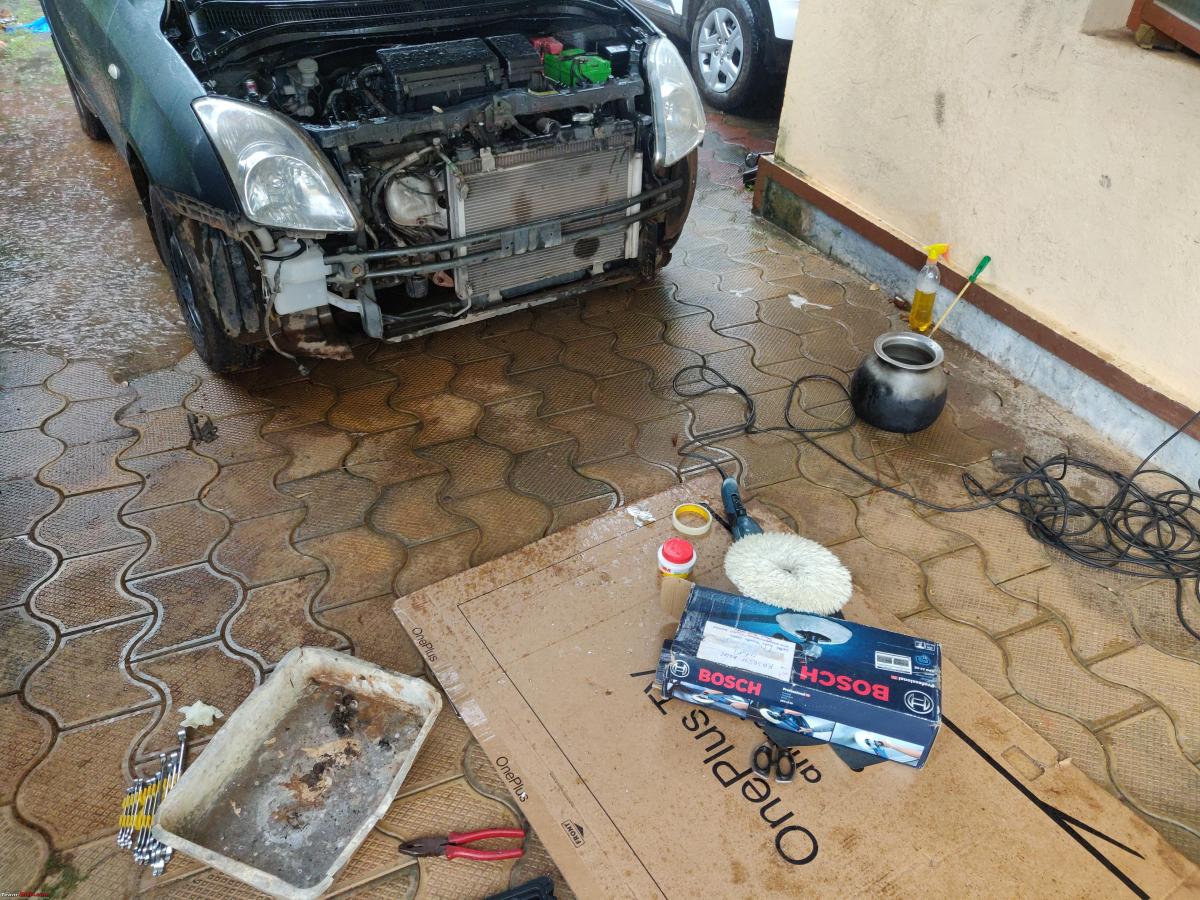
2) Wipe the headlight using a clean cloth.
3) Mask the edges of the fender panel so as to not scratch it when sanding.
4) Once done with masking, spray water on your sandpaper and plenty on your headlight too .
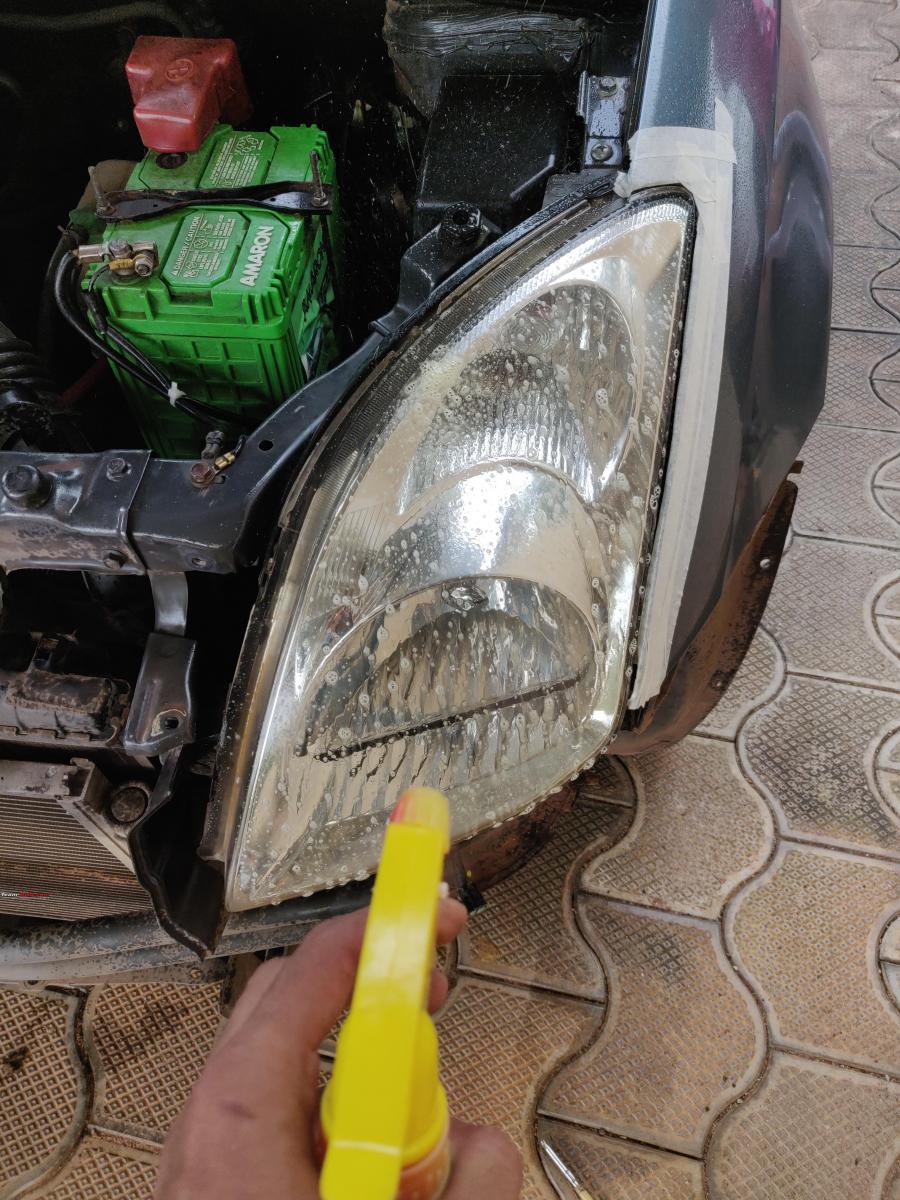
5) Wet sand it evenly with the 800 grit paper first. Do not sand in a circular motion and make sure to constantly spray your sandpaper and headlight with water. Wipe down all the residue from the headlight by pouring a mug of water on it. Yes, you will require a lot of elbow grease for the sanding.

6) Make sure you sand it till you get an even finish on your headlights and all the yellowness and oxidization has gone. I had to sand my headlight with 800 grit for about 4 passes because the overspray clear coat was still present in some areas of the headlight. It will look even hazier but trust me the outcome at the end will be worth it.
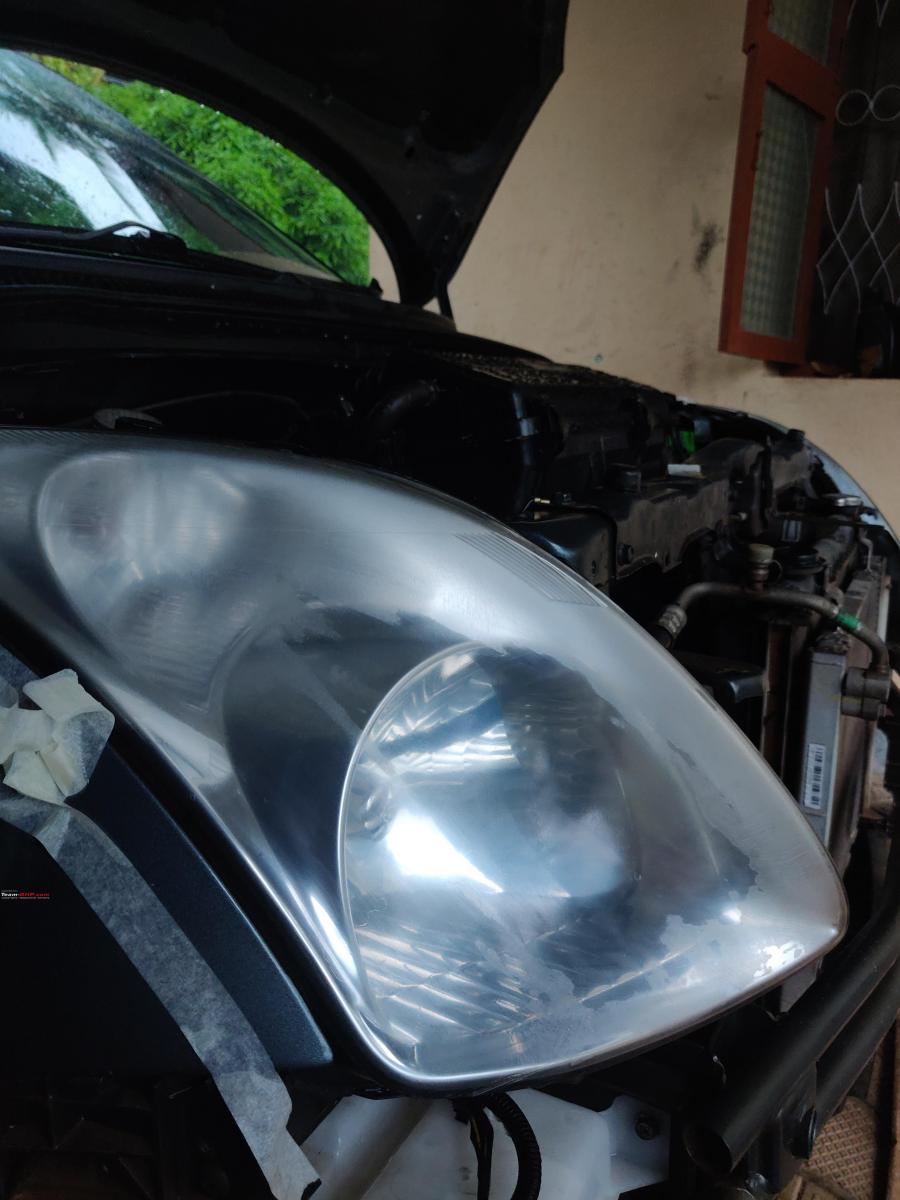

7) Proceed to 1500 grit wet sanding once an even finish is obtained and you’re happy with the 800 grit sanding. The 1500 grit sandpaper is smoother so it will even out all those scratches put by the 800 grit sandpaper.

8) Wet sand it for about two passes and you should be getting an even and smooth finish.
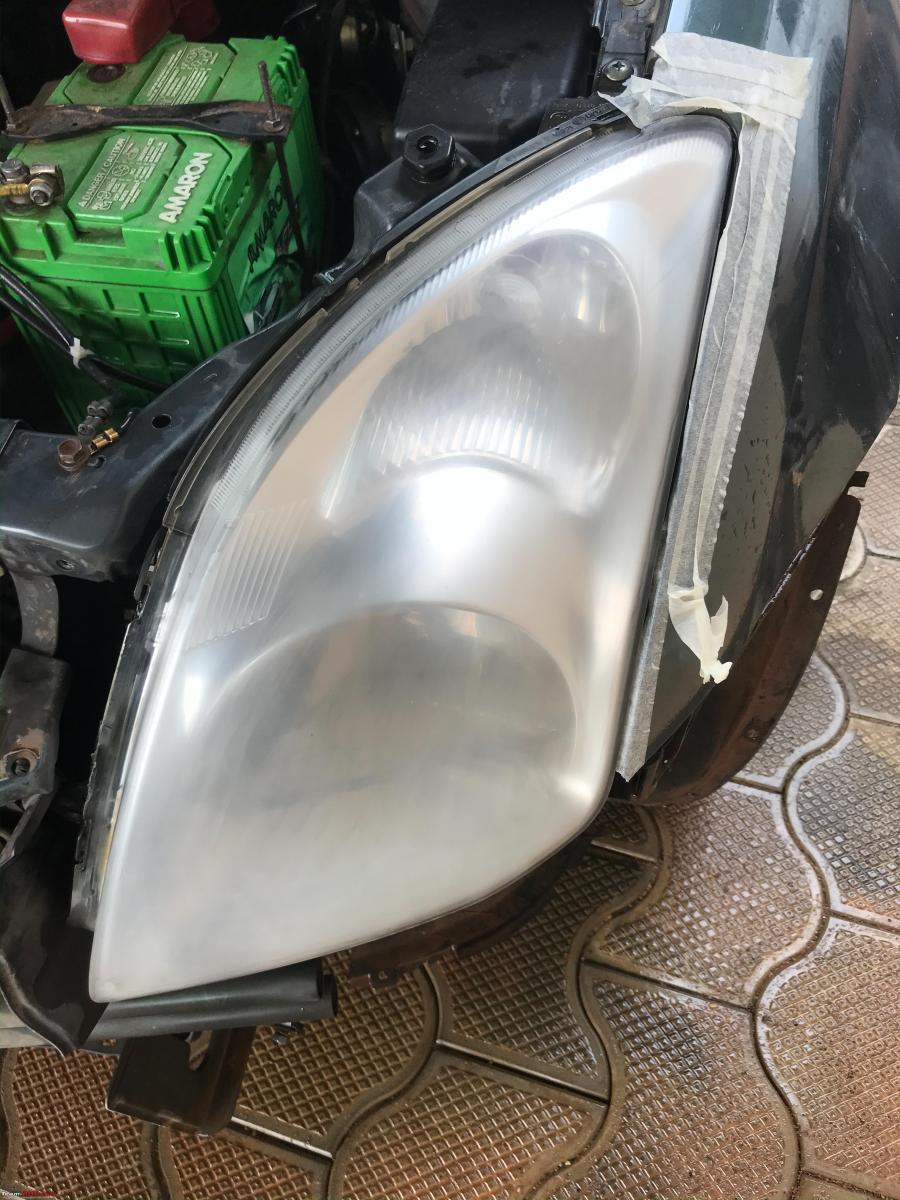
9) Pour water on the headlight again with water and clean with a microfiber cloth.
10) Now we can move on to the Rubbing compound. Take a generous amount of it and smudge it on the headlight evenly. Yes I think I was a bit too generous. Sprinkle few drops of water on it. Set the speed of the machine to low speed. Make sure the wool pad of the orbital polisher is clean.

11) Now you want to make sure that you take your time with the Polisher and not rush. Do wear an apron or something similar to it so as to not get rubbing compound splashed on your clothing. Tilt the polisher and use only the side of the Polisher. Start from one part of the headlight and work your way through. You should see the headlight clearing up in a while. Make sure to sprinkle a few drops of water on your headlights so that the heat won't melt the headlight.

12) Once you’re satisfied with polishing the headlight, Time to apply the liquid wax, it would act as a sealant. Wipe the headlight with a microfiber cloth and apply liquid wax to the headlights. Again with the polisher, work your way through just like how you did with the rubbing compound.
Voila! Your headlights should be looking crystal clear now.
NOTE: Now applying the liquid wax, again and again, every month would be irritating so applying PPF a good transparent film on the headlight would maintain its condition and protect it further.
Result After Restoring the Headlights
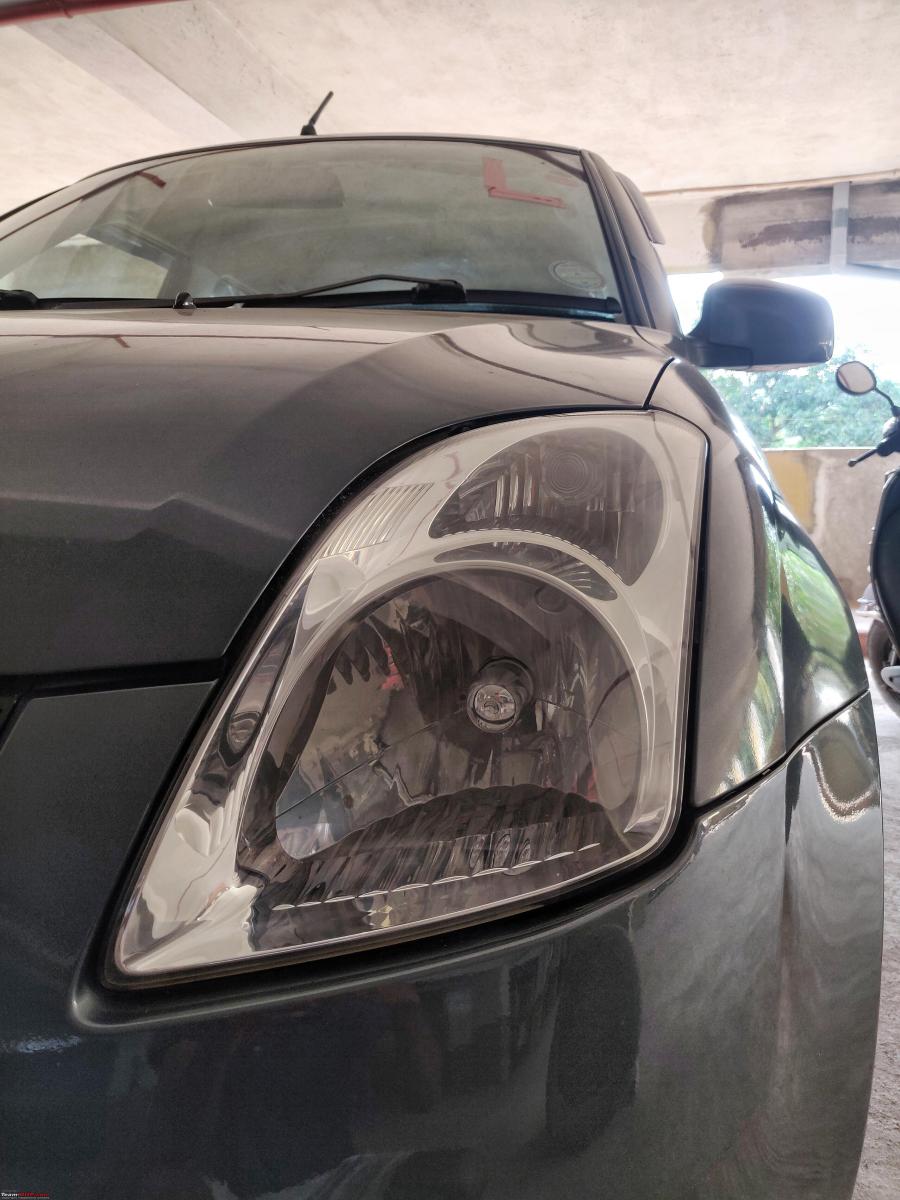
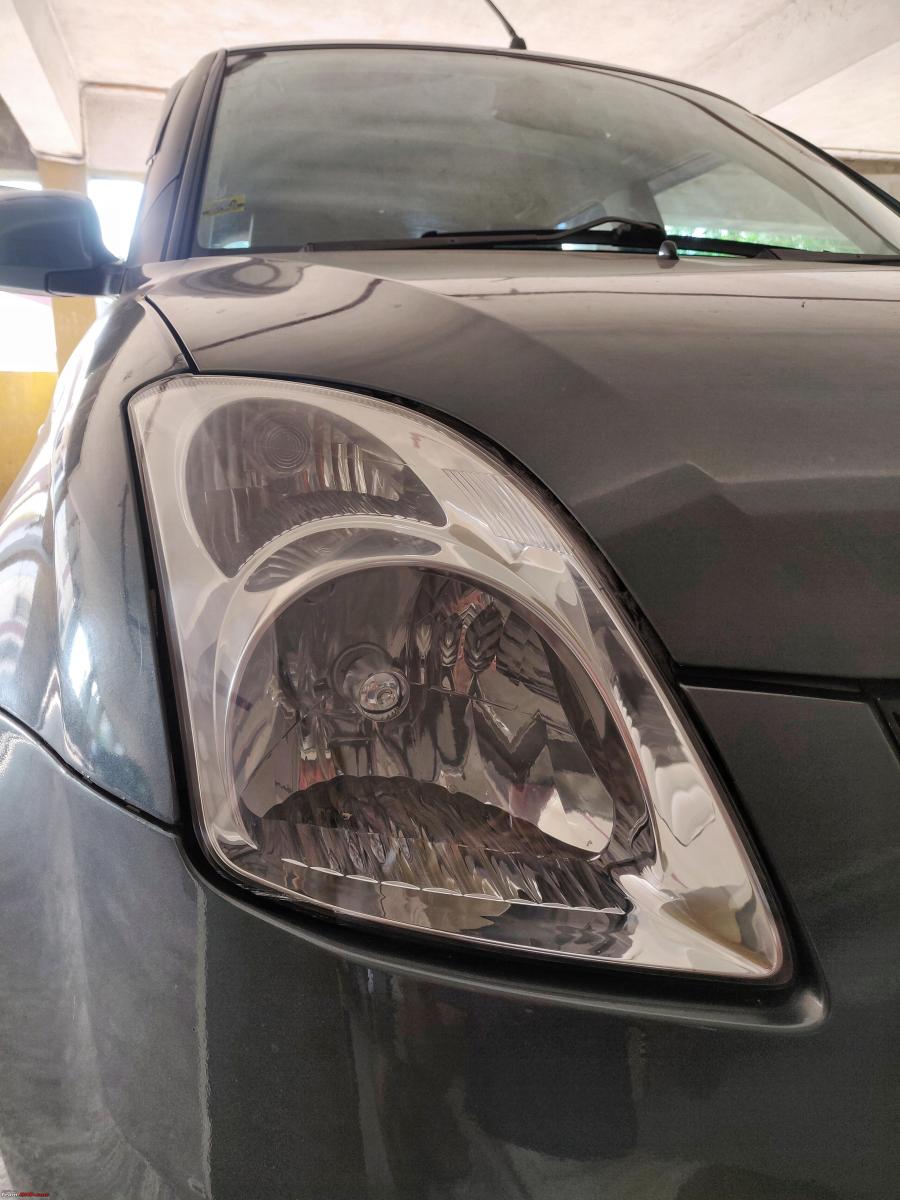
There has been a significant increase in light output post the restoration and I'm loving it. Finally, I'm getting the full output of the 90/100-watt setup installed in my car and easier night drives henceforth.
Hope this DIY helped and I'm waiting to see the before/after photos of your headlight restorations.
Check out BHPian comments for more insights and information.
- Tags:
- Indian
- DIY
- Modifications
- Swift
News
Maruti service campaign to replace faulty engine mounts
Models like the Ertiga, XL6, Swift, Dzire, Ciaz and Ignis are said to be affected by this issue.
Some Maruti Suzuki customers are said to be facing abnormal engine vibrations caused due to faulty engine mounts. In response, the carmaker has undertaken a service campaign to inspect and replace the faulty parts.
Models like the Ertiga, XL6, Swift, Dzire, Ciaz and Ignis are said to be affected by this issue. Customers have been requested to get it fixed if they notice excessive engine vibrations.
The part in question is the right-hand side engine mount; part no - 11610M72R00
The cut-off VINs for the aforementioned models are as follows:
- Ertiga: MA3BNC32SMG361698
- XL6: MA3CNC32SMG261516
- New Swift: MBHCZCB3SMG838412
- Ignis: MA3NFG81SMG319333
- Ciaz: MA3EXGL1S00437213
- Dzire: MA3EJKD1S00C76583
Cut-off date: July 22, 2021
Thanks to BHPian Leoshashi for sharing this information with other enthusiasts!
News
Rumour: Next-gen Suzuki Swift to spawn a crossover
The Swift Sport-based crossover could be powered by a 1.4L turbo-petrol mild-hybrid engine.
According to a media report, Suzuki plans to introduce a small crossover based on the next-generation Swift Sport. It could arrive by 2024.
The next-generation Suzuki Swift will be based on the updated Heartect platform. It is expected to debut sometime next year. The high-performance version called the Swift Sport is said to debut in 2023.
The Swift Sport could be powered by a 1.4-litre turbo-petrol engine paired with a 48V mild-hybrid system. The car will also feature a few chassis upgrades, including a stiffer suspension setup.
While details about the new crossover are scarce, the car could use the same 1.4-litre mild-hybrid engine as the Swift Sport, paired with Suzuki's AllGrip all-wheel-drive system.
Suzuki's new Swift-based crossover could be positioned between the Ignis and Vitara. It is still unclear if Maruti Suzuki would offer it in India.
Source: Bestcarweb
- Tags:
- Indian
- Swift
- Compact SUV
News
Maruti Vitara Brezza, Swift & Nexa range could get CNG option
At present, Maruti Suzuki offers CNG variants of the WagonR, Alto, S-Presso, and Ertiga.
As the market for alternate fuels grows, Maruti Suzuki is betting big on CNG products. According to a media report, the carmaker could introduce more CNG variants, including that of the Nexa range.
The demand for factory-fitted CNG models has been on the rise since the introduction of the WagonR S-CNG in 2010. It is said that customers are now demanding CNG options for the Vitara Brezza and Swift. Given the demand, CNG variants of the Baleno and Ciaz can't be ruled out either.
At present, Maruti Suzuki offers CNG variants of the Alto, S-Presso, and Ertiga. The Eeco, Tour S, Tour M and Super Carry LCV are also available with factory-fitted CNG kits.
In FY2017, Maruti Suzuki sold 75,000 CNG cars. In the last fiscal, this figure rose to 1,62,000 units. Maruti's total CNG car sales are expected to touch the 3 lakh unit mark by the end of FY2022.
Source: Autocar Professional
News
Need an automatic hatchback: Tiago vs i10 vs Swift vs i20
This will be a beater car which again will be only used within city, office runs, weekend runs to malls. This will also be the drive for my wife for her errands (though she hardly drives). Also will be used to ferry family within city.
BHPian sunikkat recently shared this with other enthusiasts.
Hello All,
Now this is going to be a strange comparison.
To give a bit of background, we currently have an Octavia TDI (2016 model) and an Alto 800. In current environment of working from home Alto is only used for daily errands like grocery shopping and few other purpose. The weekend drives, highways and other fun drives are taken care by Octavia. Both myself and my wife are working in the same organization which is just a km from our home, so which means once we start going back to office our daily car usage will still be less.
Now we are looking to replace the Alto 800 with a new hatchback. This will be a beater car which again will be only used within city, office runs, weekend runs to malls. This will also be the drive for my wife for her errands (though she hardly drives). Also will be used to ferry family within city.
Considering the limited use we had set the original budget of 7.5 Lakhs OTR Bangalore. However as we started searching the cars our budgets is increased to 10.5 L. Now considering for every 50k increase in budget you get a better car, we want to put cap on our maximum budget which is 11 L OTR Bangalore.
The requirements are:
- Automatic and Petrol only.
- Budget maximum of 11 Lakhs OTR Bangalore.
- Fun to drive, obviously with in the limited capacity.
- Reliable and fuss free ownership.
- Something that we can keep for 10 years minimum (though the KMs driven will be less).
Based on these criteria's we have shortlisted and test driven the Tata Tiago XZA+ Dual Tone AMT, Grand i10 Nios AMT Asta, Swift ZXI+ AMT Dual Tone and i20 1.0 Turbo iMT Sportz
Tata Tiago:

Version: Top end - XZA+ AMT Dual Tone (~ 8.5 L OTR)
Pros:
- 4 star safety rating.
- Solidly build.
Cons:
- AMT in Tiago was pretty bad in the test drive, lot of head knock feel.
- The engine did not feel peppy and that 3 cylinder roughness.
- Less space in the back to fit 3 adults.
- Very ordinary experience at the dealership. They made us walk with the 4 year old kid in that busy service road for almost half a km to and fro to the test drive car. Not a happy feeling.
- Long term reliability and service support from Tata is a big question.
Hyundai Grand i10 Nios:

Version: Top end AMT Asta (~ 9.8 L OTR)
Pros:
- Loaded to grills.
- Good quality interiors.
- AMT is the best of the cars I tested.
Cons:
- Kappa engine is not peppy as Suzuki K Series.
- Not very fun to drive, and doesn't handle like Swift.
- Both interior and exterior not to my taste (though interior quality is good).
- Flimsy build overall and bad crash test rating.
- The front seats were not comfortable for my build, there is hardly any side bolsters.
Suzuki Swift:

Version: Top end ZXI+ AMT (~ 10.7 L OTR)
Pros:
- The top end is fully loaded with projector LEDs, DRLs, Apple car play, hill hold assist etc. No need to spend much on aftermarket fitments.
- Though not fun as previous generation Swifts, this car is still fun to drive and the 2021 engine update has made it more fun. The engine I felt is much better than i10 Nios.
- Though the AMT is not as good as i10, I was happy with the overall response. Much better than Tiago and can easily live with it (provided its reliable too).
- The quality of interiors is lesser than i10, but I liked the layout, styling, black colour etc. This is more sporty and seats are supportive too. Flat bottom steering wheel and those aluminum touches makes it more sporty.
- Totally happy with the dealership experience, no one can beat this. Surely easy to live with, infact there is a Maruti dealership / service center next to our apartment.
Cons:
- Flimsy build and poor crash test rating.
- Is it worth considering top end 10.7 lakhs is in the range of premium hatchbacks.
- Did not consider Baleno as I found the AMT in Swift to be better than CVT. Also Baleno CVT is not updated with Dualjet engine (down by 7 bhp against Swift) and a newer version is coming.
Hyundai i20:

Version: 1 L Turbo iMT Sportz (~ 11 L OTR).
Did not do a test drive of iMT yet, but have driven my friend's 1.0 L Turbo DCT i20 extensively. Considering i20 only for turbo engine.
Pros:
- Car from a segment above - premium hatchback.
- Fun to drive turbo engine (if not compared to Polo).
- More exclusivity, as lesser new gen i20s on road than Swift.
- More premium feel than other options here.
Cons:
- Low end version - Would need to get many things from aftermarket like alloys, leather wrap steering, apple car play, LED lights etc.
- iMT is still a manual and we need to engage gears - will it be as convenient like AMT / CVT?
- Will the turbo engine be convenient like NA engine in the city traffic?
- Okay build and questionable safety rating.
Honda Jazz:

Now this is a wild card entry. Have never driven Jazz, but have extensively driven all generations of City and I am not a big fan of it. Though Jazz has more premium feel and space, worried about the future of Honda and Jazz. Are they going to continue this model with ~ 700 units per month. Is it worth considering Jazz? How good is the real world performance? The mid variant comes in my budget.
If the car was only for me I would have closed my eyes and bought a Polo TSI GT (even if slightly more expensive). But since this will be mainly used to ferry family within city I need more space. Also wifey needs more features, so Polo is out.
Nissan / Renault are not considered due to limited dealership support and I need a fuss free ownership, not confident of them yet.
Venue / Sonet are not considered as they only have iMT or DCT which is not my preference. Also wanted to restrict my budget to 11 Lakhs, otherwise we will keep increasing our budget and finally buy Kushaq 1.5 TSI . I would as well save that money and use it for upgrading my Octavia whenever I am ready for it. For this reason Nexon is out too.
With all the good work Tata has done on safety, I really wanted to buy Tiago. But the car was underwhelming and dealership experience was pretty bad. Only safety is going for Tiago. Altroz doesn't have automatic.
There are so many cars in the market, yet finding one is difficult. Now after prioritizing all our requirements and considering this car will hardly ever see highways we are planning to finalize on Swift. It is fast, fun, sporty, looks good and unbeatable Maruti experience.
So this is the dilemma I have. Appreciate any feedback and suggestions.
Here;s what BHPian saisree had to say on the matter:
Your requirements points to the Jazz. It may not be that pouncing tiger, but, for sure is a ideal family workhorse. With all that space, non claustrophobic, reliable iVTec its worth the penny put on it. And, I feel Honda is not going out.
Here's what BHPian RavSam had to say on the matter:
With your shortlisting, I would say the Swift. Safety rating being the only concern.
Maruti Suzuki AMTs are refined with every iteration. So would not worry much about that.P.S. And since you don't want to stretch your budget, I would not recommend the Ertiga VXi AT.
Check out BHPian comments for more insights and information.
News
Installing multiple DIY modifications in my old Maruti Swift
The auto-dimming IRVM he used is mounted on the windshield & his installation was really clean. This gave me confidence that this mod should also be possible in my Swift.
BHPian chiranjitp recently shared this with other enthusiasts.
A tale of two DIYs
1) Auto Dimming IRVM:
Our 2016 Ecosport comes with an Auto dimming IRVM, which I personally find very useful during night driving. It was always in my mind to do this mod in my Swift, however lack of expertise & cost kept me from completing it. Then few months back Dbhpian Leoshashi installed an auto IRVM in his Maruti XL6 MPV. The stock IRVM on the XL6 is mounted like on my Swift, on the roof (many cars have the IRVM mounted on the windshield). The Auto dimming IRVM he used is mounted on the windshield & his installation was really clean. This gave me confidence that this mod should also be possible in my Swift. The cost of the project using Maruti parts would have been between Rs 3.5k to 6k, which is very reasonable for getting an Auto IRVM.
Friend, fellow 06 Swift owner & Bhpian Ashtoncastelino pinged me one day regarding installing Auto IRVM in our cars, he also sent me a Boodmo link for a Honda Auto IRVM. I opened that link & was shocked to see the price (Rs. 422). I was certain that there was some error on part of Boodmo regarding the pricing or that it was not an Auto dimming IRVM. A normal IRVM from Maruti cost around that much & here was an Auto dimming IRVM for that price, that too from Honda. Then I found out that Bhpian vaasu has used this IRVM on his 4th gen Honda City. I pinged him regarding my doubts, he assured me this mirror is indeed Auto dimming & that it works perfectly.
Part number: 76400T4RJ11
Price: Rs. 422.
Boodmo Link
Ashton & I thereafter placed an order for the Honda IRVM on Boodmo. As for the mount, we decided we will have to get it from scrap. Thankfully Ashton found two mounts in a workshop, he immediately shipped one over to me. I again carefully went through the photos of the mount Shashi used & also went through Dbhpian Laluks's thread (he fitted Auto IRVM in his Fortuner). All of these mount look same, so I am quite certain that at-least all the Japanese manufactures use one design for the IRVM mount. None of them however sell the mount separately, it comes stuck to the windshield. The MGA Celerio Auto IRVM kit (cost around 6k) comes with the mount & glue to stick it to the windshield, so I was quite certain that the mount could be stuck separately without any issue.
Honda City mount (the one we used)

Maruti Celerio MGA mount:

Toyota Fortuner stock mount:

Boodmo delivered the IRVM within one week. The Honda City IRVM connector comes with 5 wires, the red wire is +ve, the black wire is -ve. I haven't yet figured out what the rest of the wires are for, I think one of them will be for the reverse signal. I did a trial run from the battery, the Auto IRVM worked perfectly. So, finally I was sure that this IRVM has auto dimming functionality.
The packaging:

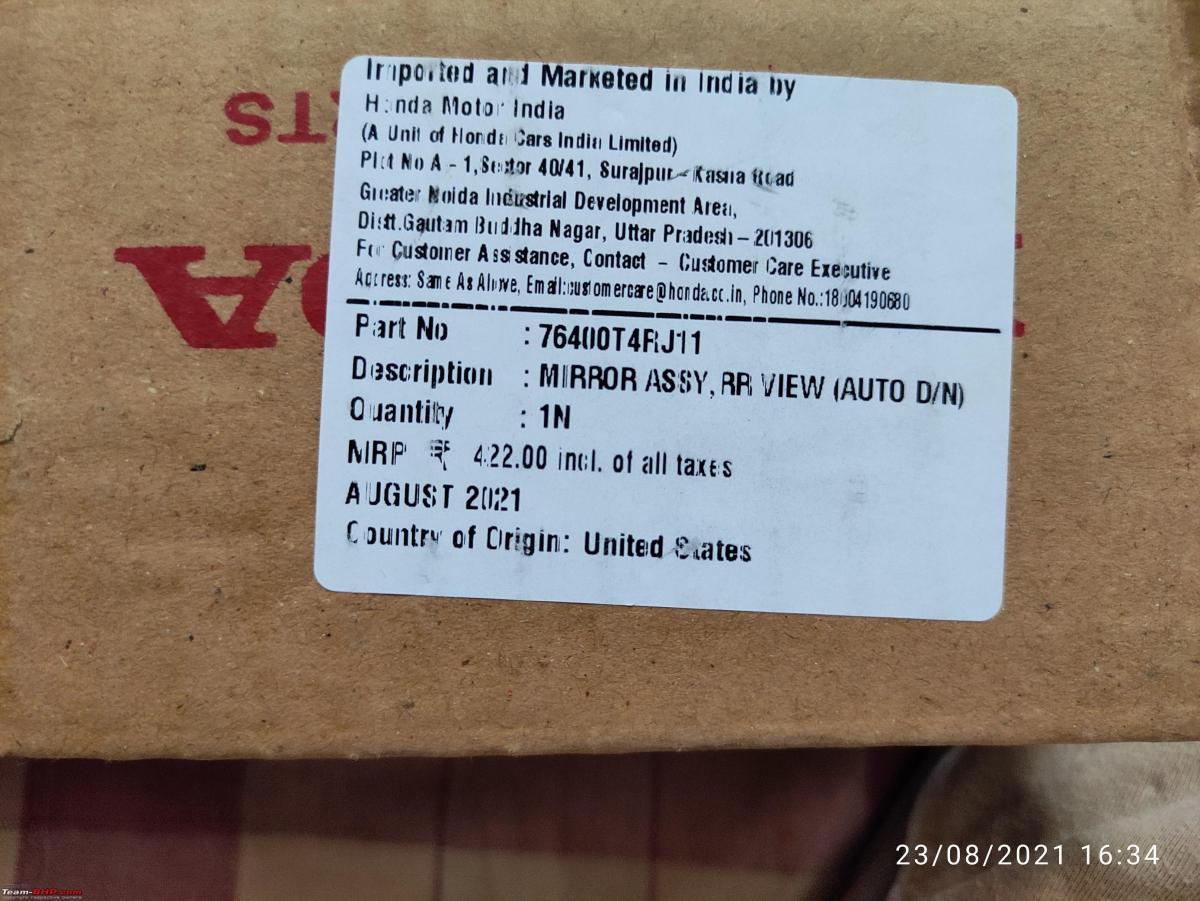
The Honda Auto IRVM, looks very sleek:


The connector:
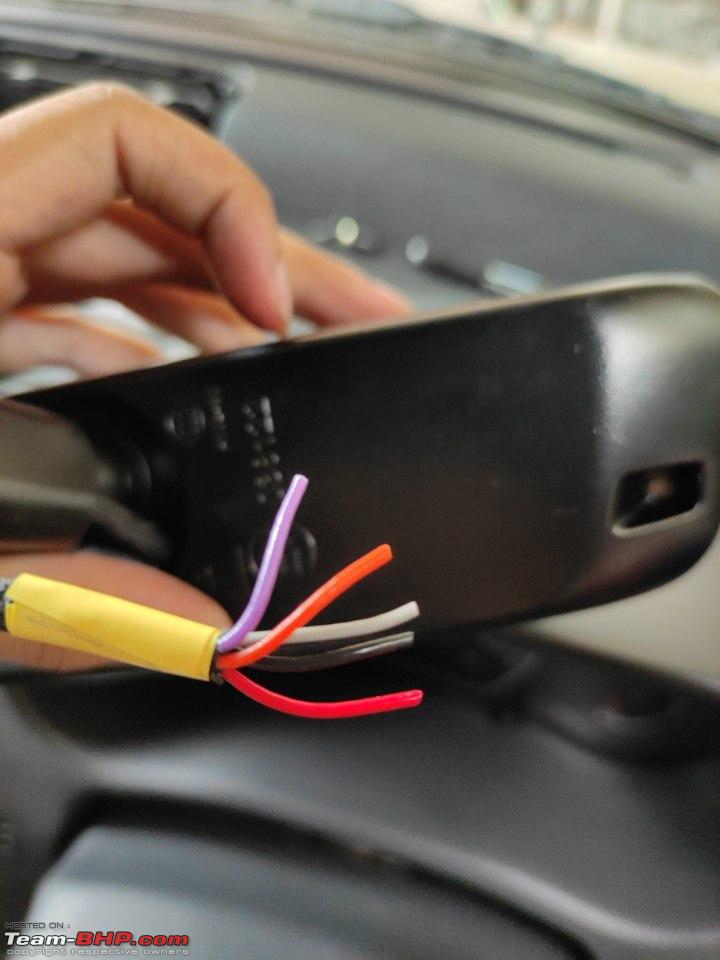

Comparison with the OE IRVM:

Comparison with 2016 Ecosport's stock Auto IRVM:

Next up was to fix the mount properly, the Auto IRVM weighs around 500g. I went to a hardware store & told them my requirement, he suggested me a Fevitite adhesive (all-purpose epoxy adhesive). I stuck the mount carefully after taking proper measurements & let the glue dry properly for 1 day. Then finally mounted the IRVM, the IRVM is tightened to the mount with a torx screw. I checked the IRVM, it seemed like a solid fit.
The glue that was used:

IRVM mount stuck to the windshield:

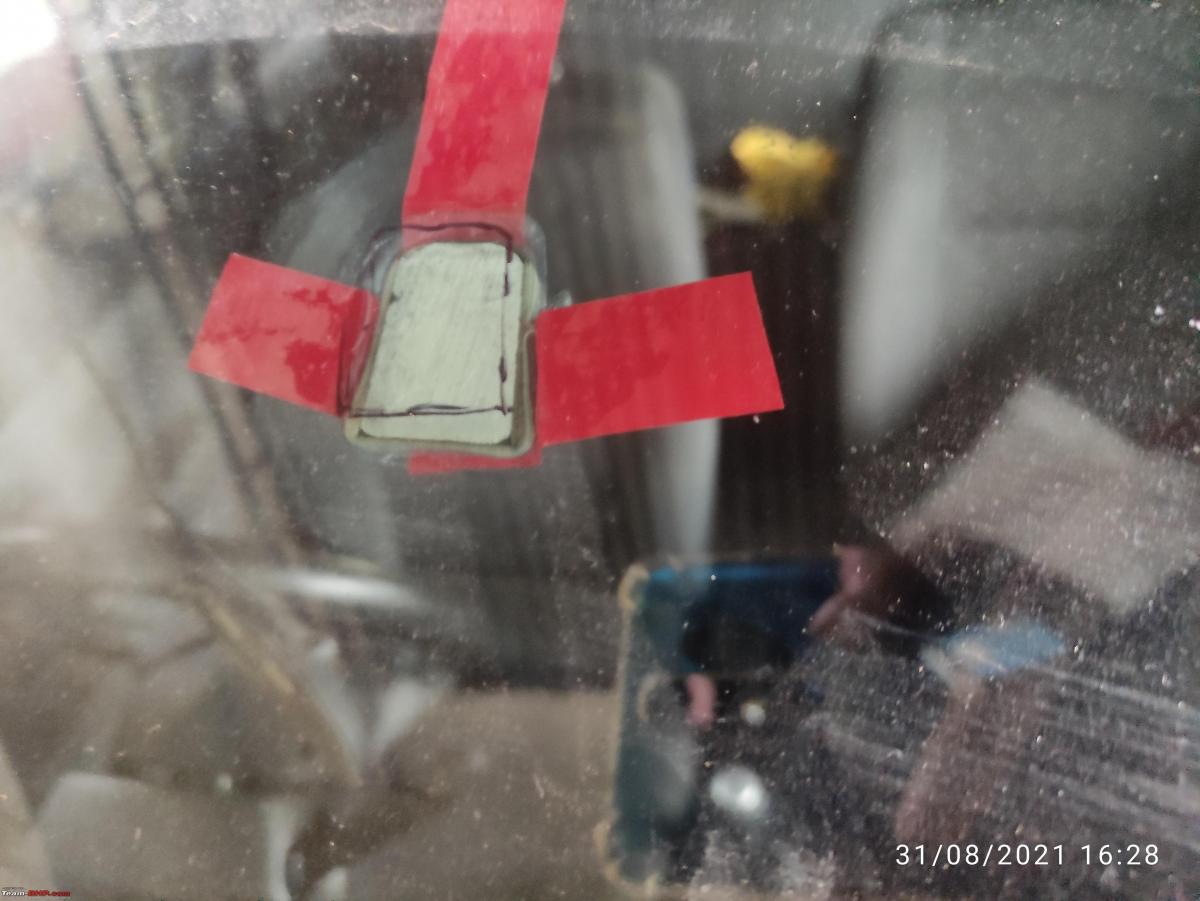
Next up was the wiring, I used a fuse tap for the 12V supply (+ve), the ground (-ve) was taken from a bolt on the A pillar. The wiring was neatly tucked under the roof liner. All the wire joints were soldered properly & a heat shrink tube placed over it. I took the Swift out for a small night drive, the auto dimming function performed flawlessly, like the stock Auto IRVM on our Ecosport. Bhpian Ashtoncastelino has also completed the mod in his 06 Swift VXi, special thanks to him for making this happen.
A pillar trim removed:

Fuse tap:

Final look from outside, could have been a bit cleaner:
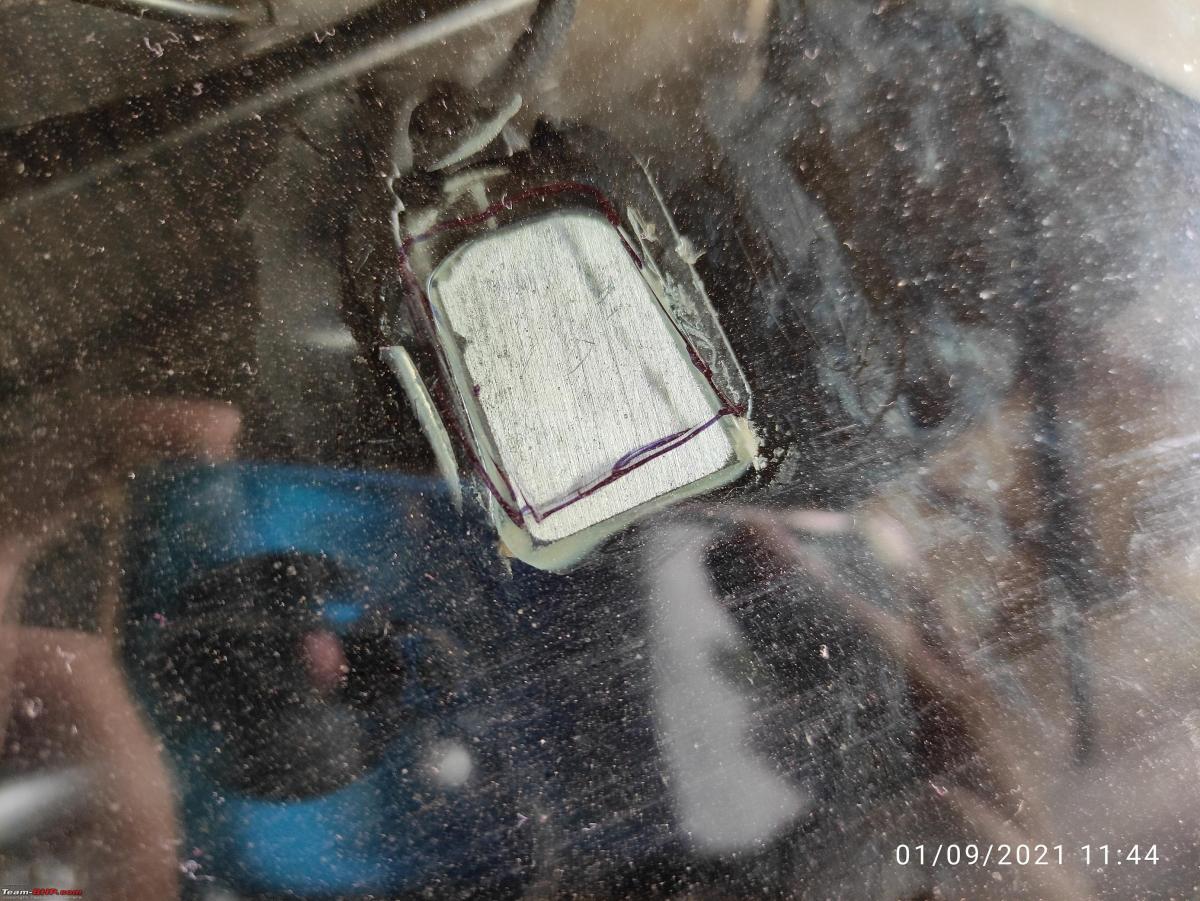
Auto IRVM in place:

Auto IRVM in action (this photo was clicked by a rear passenger):

Continue reading about chiranjitp's DIY modifications for more insights, information and BHPian comments.
- Tags:
- Indian
- Swift
- DIY
- Modifications
News
Maruti Suzuki Swift sales cross the 25 lakh mark
The Maruti Swift was the no.1 selling car of FY2020-21.
Maruti Suzuki has achieved a new milestone as the cumulative sales of the Swift cross the 25 lakh unit mark.
The Swift was launched in the Indian market in 2005. Within 5 years, Maruti had sold over 5 lakh cars. By 2013, 10 lakh units were sold and in 2018, the cumulative sales of the model crossed the 20 lakh mark. The Swift was the no.1 selling car of FY2020-21.
The third-generation Swift was launched at the 2018 Auto Expo. The car is based on the fifth-generation Heartect platform. It is powered by a 1.2-litre, 4-cylinder petrol engine that produces 89 BHP @ 6,000 rpm and 113 Nm of torque @ 4,400 rpm. The engine is mated to a 5-speed manual transmission.
News
Tata takes a dig at the Swift for poor safety rating
This isn't the first time Tata is targetting its rivals for poor safety ratings.
Last week, we reported that the made-in-India Maruti Suzuki Swift failed the Latin NCAP crash test, securing a zero-star rating.
Tata has now taken to social media to take a dig at the Swift's poor result. Tata uploaded a picture mocking the Swift's zero-star rating, with a caption that read:
Latest NCAP safety test shows that it’s not safe to ride ‘Swift’ly. Yet another reason for you to book New Tiago - the #SeriouslyFun hatchback rated 4 stars for safety by Global NCAP.
While the Swift failed the Latin NCAP crash test, the hatchback received a 2-star rating in the Global NCAP crash test in 2018.
This isn't the first time Tata is targetting its rivals for poor safety ratings. The Indian carmaker has taken a dig at the Maruti S-Presso, WagonR as well as the Hyundai Grand i10 Nios in the past.
Pages




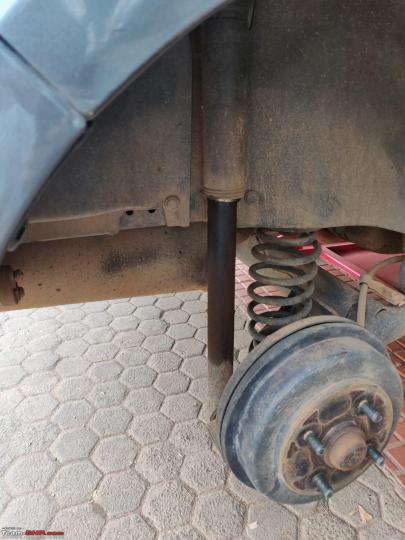


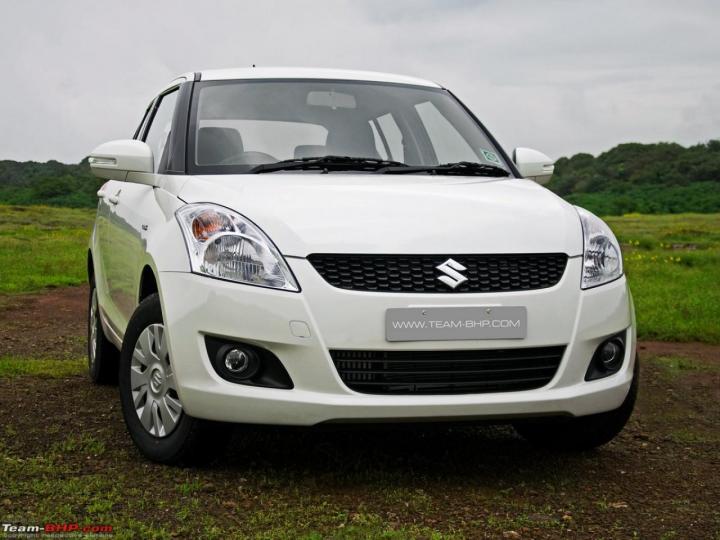

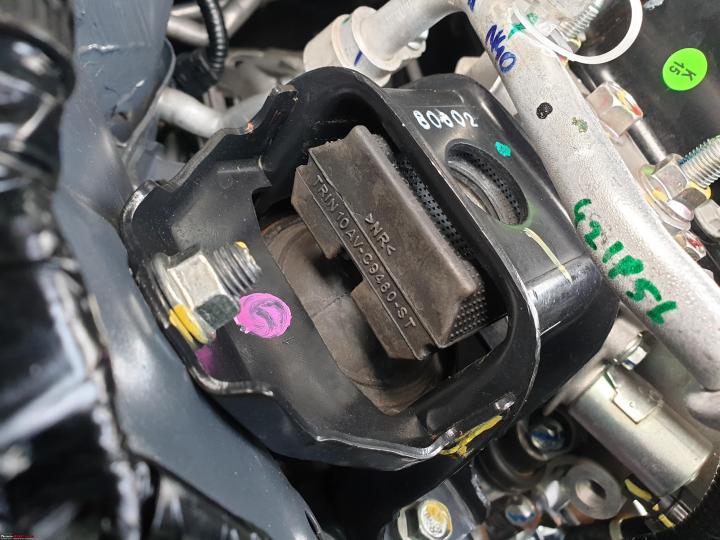
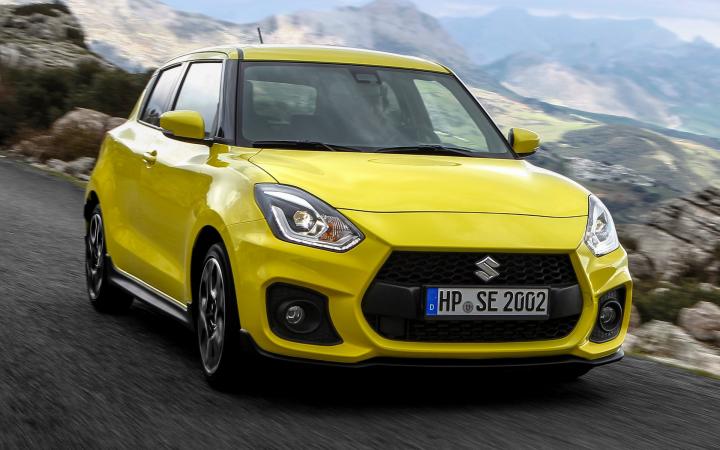
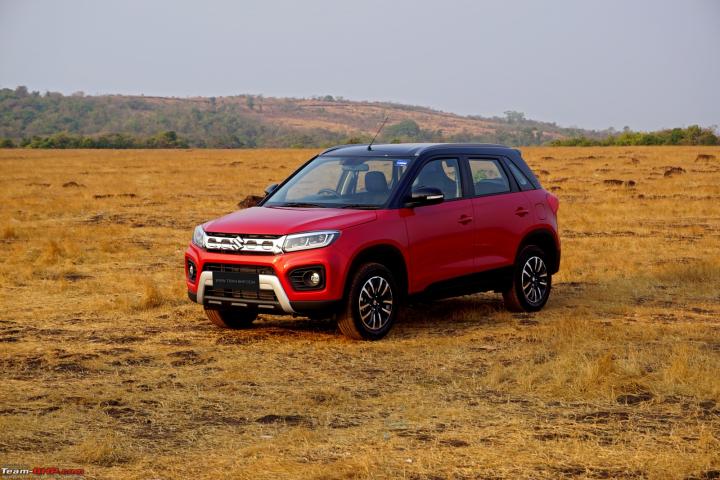


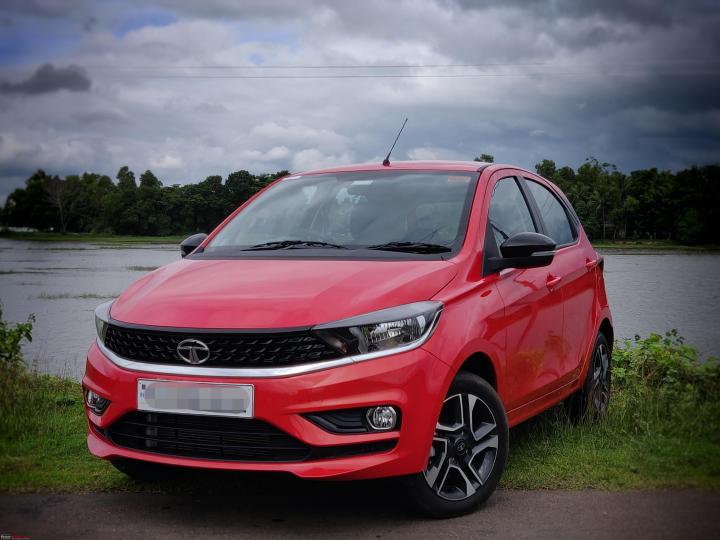





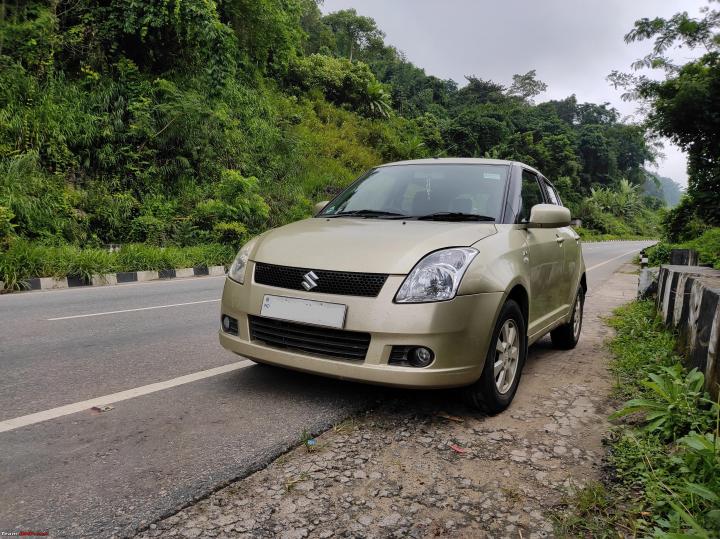
_3.jpg)

